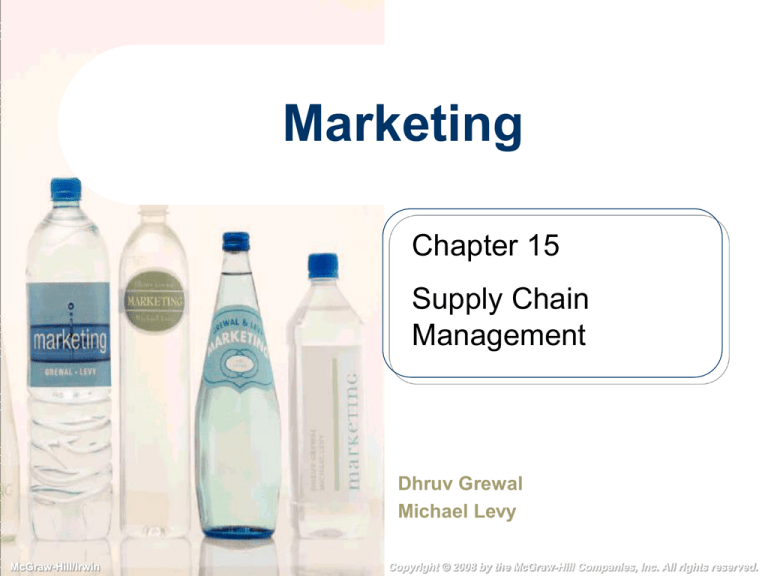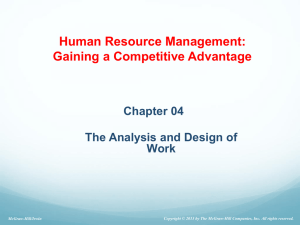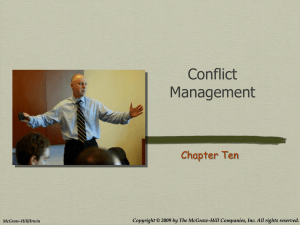
Marketing
Chapter 15
Supply Chain
Management
Dhruv Grewal
Michael Levy
McGraw-Hill/Irwin
Copyright © 2008 by the McGraw-Hill Companies, Inc. All rights reserved.
15-2
Zara
Differentiates itself by owning
the majority of their stores
Produces a majority of its
own clothes
Makes over 40% of its own
fabric
Operates a worldwide
distribution network
© 2007 McGraw-Hill Companies, Inc., McGraw-Hill/Irwin
15-3
Supply Chain Management
© 2007 McGraw-Hill Companies, Inc., McGraw-Hill/Irwin
15-4
Supply Chain, Marketing Channels, and
Logistics are Related
Marketing channel
Logistics management
Similar but different
© 2007 McGraw-Hill Companies, Inc., McGraw-Hill/Irwin
15-5
Supply Chains Add Value
© 2007 McGraw-Hill Companies, Inc., McGraw-Hill/Irwin
15-6
Supply Chains Streamline Distribution
Reduce number of transactions
Increase value for consumers
More efficient and effective
© 2007 McGraw-Hill Companies, Inc., McGraw-Hill/Irwin
15-7
Test Your Knowledge
One expensive solution firms used in the past to reduce
distribution time was to _______________.
A)
hire their own truckers
B)
make several small shipments every day
C)
reduce inventory
D)
stockpile inventory
15-8
Supply Chain Management Affects
Marketing
Fulfilling delivery promises
Meeting customer
expectations
Reliant on an efficient
supply chain
© 2007 McGraw-Hill Companies, Inc., McGraw-Hill/Irwin
15-9
Volvo Meeting Expectations
Developing a system that lets
customers know exactly when
their car will be delivered
© 2007 McGraw-Hill Companies, Inc., McGraw-Hill/Irwin
15-10
Case in Point: Volvo Logistics
Challenge
To coordinate all systems so that
exact delivery days can be issues
when an order is placed.
Answer
Using EDI to create “4D” the world’s
first distribution system that is totally
integrated with order and production
systems. Matches production with
programmed distribution routes.
Results
Targeted at 98% reliability. Improved
customer satisfaction and loyalty.
15-11
Making Information Flow
Flow 1 (Customer to Store)
Flow 2 (Store to Buyer)
Flow 3 (Store to Manufacturer)
Flow 4 (Store to Manufacturer)
Flow 5 (Store to Distribution Center)
© 2007 McGraw-Hill Companies, Inc., McGraw-Hill/Irwin
15-12
Information Flows
© 2007 McGraw-Hill Companies, Inc., McGraw-Hill/Irwin
15-13
Electronic Data Interchange
Advanced shipping notice
Intranet
Extranet
CPFR
© 2007 McGraw-Hill Companies, Inc., McGraw-Hill/Irwin
15-14
Test Your Knowledge
Why is it crucial for marketers to understand the information
flows through the supply chain?
A)
This ensures the timely delivery of goods.
B)
This ensures that customers find the goods they
desire in the store ready for purchase.
C)
This ensures that the manufacture is aware of
potential stock outs and other issues at the retail
level.
D)
All of these choices are correct.
15-15
Making Merchandise Flow
© 2007 McGraw-Hill Companies, Inc., McGraw-Hill/Irwin
15-16
Inbound Transportation
Dispatcher coordinates
deliveries
Manufacturer may pay
transportation expenses
Or retailers negotiate directly
with trucking companies and
pay expenses.
© 2007 McGraw-Hill Companies, Inc., McGraw-Hill/Irwin
15-17
Receiving and Checking
Receiving
–
Checking
–
–
Arrival receipt
Undamaged
Ordered = received
Radio Frequency Distribution
(RFID) Tags
–
Container computer chips
15-18
Storing and Cross-Docking
Traditional
Cross-docking
Combinations
© 2007 McGraw-Hill Companies, Inc., McGraw-Hill/Irwin
15-19
Adding Value 15.1: RFID Tracks Merchandise
Through Marks and Spencer
Track individual piece of
merchandise sent to vendor
Used to locate mislaid products,
deter theft
Enables distribution centers to
receive whole truckloads
© 2007 McGraw-Hill Companies, Inc., McGraw-Hill/Irwin
15-20
Getting Merchandise Floor-Ready
Ticketing and marking
Increasingly firms are
forcing suppliers to ship
floor ready merchandise
© 2007 McGraw-Hill Companies, Inc., McGraw-Hill/Irwin
15-21
Test Your Knowledge
Where is the
take place?
A)
B)
C)
D)
most efficient place for ticketing and marking to
retail floor
distribution center
receiving area of retail store
cross-dock
15-22
Shipping Merchandise to Stores
Shipping merchandise to stores is
complex for multi-store chains
Distribution centers use
sophisticated routing and
scheduling systems
© 2007 McGraw-Hill Companies, Inc., McGraw-Hill/Irwin
15-23
Inventory Management Through Just-InTime Systems
Just-in-time (JIT)
Quick response (QR)
© 2007 McGraw-Hill Companies, Inc., McGraw-Hill/Irwin
15-24
Benefits of JIT Systems
Reduced lead time
Increased product availability and
lower inventory investment
© 2007 McGraw-Hill Companies, Inc., McGraw-Hill/Irwin
15-25
Designing a Supply Chain: Supply
Chain Structure
© 2007 McGraw-Hill Companies, Inc., McGraw-Hill/Irwin
15-26
Influences on Supply Chain Structure
Customer
expectations
Supply chain
member
characteristics
© 2007 McGraw-Hill Companies, Inc., McGraw-Hill/Irwin
15-27
Distribution Intensity
Intensive
Selective
Exclusive
© 2007 McGraw-Hill Companies, Inc., McGraw-Hill/Irwin
15-28
Test Your Knowledge
Exclusive distribution can benefit manufacturers by assuring
them that _______________ buy their products.
A)
a large number of retailers
B)
the most appropriate customers
C)
customers with the highest profit margins
D)
global customers
15-29
Managing the Supply Chain
Supply chain or channel conflict
15-30
Managing Supply Chains Through Vertical
Integration
Independent or conventional supply chain
© 2007 McGraw-Hill Companies, Inc., McGraw-Hill/Irwin
15-31
Types of Vertical Marketing Systems
Independent or
conventional
supply chain
Administered
vertical marketing
system
Contractual
vertical marketing
system
Corporate
vertical marketing
system
© 2007 McGraw-Hill Companies, Inc., McGraw-Hill/Irwin
15-32
Managing Supply Chains Through
Strategic Relationships
Strategic relationship (partnering relationship)
© 2007 McGraw-Hill Companies, Inc., McGraw-Hill/Irwin
15-33
Test Your Knowledge
Strategic relationships are created explicitly to
_______________, so members depend on and trust each
other heavily.
A)
decrease distribution time
B)
avoid lawsuits
C)
uncover and exploit joint opportunities
D)
maintain a vertical marketing system
15-34
Supplier Managed Inventory
How to get a perishable product
produced in one country delivered to
another on time and still fresh?
© 2007 McGraw-Hill Companies, Inc., McGraw-Hill/Irwin
15-35
Case in Point: Guinness
Challenge
Answer
Results
99% of the product left the UK on
time but only 59% arrived on
time.
Partner with SAP using their See
Why software began to identify
issues in container shipments to
U.S. and track demand and
delivery.
Set up a Supplier Management
Inventory system in the U.S.
Allowing Guinness to maintain stock
and predict demand for the U.S.
market. Better able to schedule
shipping and contain costs.
15-36
Ethical Dilemma 15.1: Can RFIDs Keep a
Secret?
Cons:
Pros:
Streamline
supply chain
Anti-theft
Tracks
whereabouts
Personal
information not
secure
Privacy
Tracks
whereabouts
© 2007 McGraw-Hill Companies, Inc., McGraw-Hill/Irwin
15-37
Chapter 15 Glossary
Administered vertical marketing system: A supply chain system in which there is no common
ownership and no contractual relationships, but the dominant channel member controls the channel
relationship.
Advanced shipping notice: An electronic document that the supplier sends the retailer in advance
of a shipment to tell the retailer exactly what to expect in the shipment.
Collaboration, planning, forecasting, and replenishment (CPFR): An inventory management
system that uses an electronic data interchange (EDI) through which a retailer sends sales
information to a manufacturer.
Contractual vertical marketing system: A system in which independent firms at different levels of
the supply chain join together through contracts to obtain economies of scale and coordination and to
reduce conflict.
Corporate vertical marketing system: A system in which the parent company has complete control
and can dictate the priorities and objectives of the supply chain; it may own facilities such as
manufacturing plants, warehouse facilities, retail outlets, and design studios.
Electronic data interchange (EDI): The computer-to-computer exchange of business documents
from a retailer to a vendor and back.
Extranet: A collaborative network that uses Internet technology to link businesses with their
suppliers, customers, or other businesses.
Independent or conventional supply chain: The several independent members—a manufacturer, a
wholesaler, and a retailer—each attempt to satisfy their own objectives and maximize their own
profits, often at the expense of the other members.
Intranet: A secure communication system contained within one company, such as between the firm’s
buyers and distribution centers.
© 2007 McGraw-Hill Companies, Inc., McGraw-Hill/Irwin
15-38
Chapter 15 Glossary (continued)
Just-in-time (JIT): Inventory management systems designed to deliver less merchandise on a more
frequent basis than traditional inventory systems; the firm gets the merchandise “just in time” for it to
be used in the manufacture of another product, in the case of parts or components, or for sale when
the customer wants it, in the case of consumer goods.
Logistics management: The integration of two or more activities for the purpose of planning,
implementing, and controlling the efficient flow of raw materials, in-process inventory, and finished
goods from the point of origin to the point of consumption.
Marketing channel: The set of institutions that transfer the ownership of and move goods from the
point of production to the point of consumption; consists of all the institutions and marketing activities
in the marketing process.
Quick response: An inventory management system used in retailing; merchandise just in time for
sale when the customer wants it.
Strategic relationship (partnering relationship): A supply chain relationship that the members are
committed to maintaining long term, investing in opportunities that are mutually beneficial; requires
mutual trust, open communication, common goals, and credible commitments.
Supply chain conflict (channel conflict): Results when supply chain members are not in
agreement about their goals, roles, or rewards.
Supply chain management: Refers to a set of approaches and techniques that firms employ to
efficiently and effectively integrate their suppliers, manufacturers, warehouses, stores, and other
firms involved in the transaction into a seamless value chain.
Ticketing and marking: Creating price and identification labels and placing them on the
merchandise.
© 2007 McGraw-Hill Companies, Inc., McGraw-Hill/Irwin








